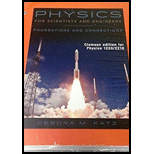
Concept explainers
A One of the slits in a Young’s double-slit apparatus is wider than the other, so that the amplitude of the light that reaches the central point of the screen from one slit alone is twice that from the other slit alone. Determine the resultant intensity as a function of the direction
The resultant intensity as a function of the wavelength of the incident light
Answer to Problem 89PQ
The resultant intensity as a function of the wavelength of the incident light
Explanation of Solution
Given that the one of the slit in the Young’s double slit apparatus is wider than the other, so that the amplitude of the light on the central portion is twice alone than the other.
Write the relation of the intension anywhere on the screen.
Where,
Here,
The amplitude of light from first slit.
The amplitude of the light from other slit.
Here,
The resultant amplitude
Conclusion:
Substitute,
Take square both the sides.
Take
Substitute,
Substitute,
Substitute,
Substitute,
Therefore, the resultant intensity as a function of the wavelength of the incident light
Want to see more full solutions like this?
Chapter 35 Solutions
Physics for Scientists and Engineers: Foundations and Connections
- A student shines a red laser pointer with a wavelength of 675 nm through a double-slit apparatus in which the two slits are separated by 75.0 m. He observes the diffraction pattern on the wall 1.50 m away. What is the distance between the central bright fringe and either of the neighboring bright fringes on the wall?arrow_forwardA Two slits are separated by distance d and each has width w. If d = 2w, how many bright fringes are within the central maximum of the diffraction pattern?arrow_forward(a) Assume that the maxima are halfway between the minima of a single-slit diffraction pattern. The use the diameter and circumference of the phasor diagram, as described in Intensity in Single-Slit Diffraction, to determine the intensities of the third and fourth maxima in terms of the intensity of the central maximum. (b) Do the same calculation, using Equation 4.4. I=I0( sin)2 (4.4)arrow_forward
 Physics for Scientists and Engineers: Foundations...PhysicsISBN:9781133939146Author:Katz, Debora M.Publisher:Cengage Learning
Physics for Scientists and Engineers: Foundations...PhysicsISBN:9781133939146Author:Katz, Debora M.Publisher:Cengage Learning University Physics Volume 3PhysicsISBN:9781938168185Author:William Moebs, Jeff SannyPublisher:OpenStax
University Physics Volume 3PhysicsISBN:9781938168185Author:William Moebs, Jeff SannyPublisher:OpenStax

